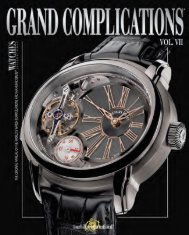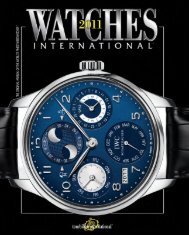180 YEARS OF
180 YEARS OF
180 YEARS OF
You also want an ePaper? Increase the reach of your titles
YUMPU automatically turns print PDFs into web optimized ePapers that Google loves.
No doubt about it – Longines is one of the world’s most<br />
successful watch brands. e brand has celebrated constant<br />
growth since 2003. According to our estimates the<br />
company now produces about one million watches per<br />
year and its sales volume of around one billion Swiss<br />
francs puts it among the top ve in the industry. A good<br />
portion of these numbers are attributed to the high demand<br />
from Asian markets but growth rates in Europe<br />
and America are also substantial.<br />
Longines undoubtedly is one of the major traditional<br />
manufacturers that have made a decisive mark on the<br />
Swiss watch industry. Longines (among others) was a<br />
leader in the creation of chronographs and the timing of<br />
sporting events. e company won chronometer competitions<br />
and equipped early aviators with cockpit instruments<br />
and special wristwatches. And early on, at the<br />
beginning of the 20 th century, Longines began oering<br />
wristwatches alongside pocket watches and accessorized<br />
fashionable women with ne models of their own. e<br />
company has also always stood for quality of the rst<br />
class. Ernest Francillon, leader of the manufacture during<br />
the second half of the 19 th century, had a distinctive<br />
mark engraved on his watch movements – one that wrote<br />
marketing history. e winged hourglass was submitted<br />
to the Swiss patent oce in 1889 and is the world’s oldest<br />
logo in continuous use.<br />
e rise of inexpensive Japanese quartz watches in the<br />
1970s led to the downfall of many traditional watch manufacturers<br />
in Switzerland. Longines was not alone in<br />
ghting for survival. Fortunately the brand became part<br />
of Swatch Group in the early 1980s (then SMH) and its<br />
leader, Nicolas G. Hayek, determined the path that guaranteed<br />
the company’s successful future. Longines no<br />
longer produced movements in-house and instead relied<br />
on the centralized production by ETA, which allowed<br />
the company to concentrate on product development<br />
and marketing. It was especially important to ensure<br />
the company presented a unied image worldwide.<br />
Longines was set to regain its position as the embodiment<br />
of an elegant watch, and the strategy proved to be a<br />
complete success. Take, for example, the “La Grande<br />
Classique de Longines” collection. Since its introduction<br />
in 1992 it has lost none of its currency and has sold<br />
EDITOR’S LETTER<br />
SUCCESS<br />
more than 1 million pieces so far – all without the benet<br />
of advertising, as Longines president Walter von Känel<br />
likes to mention.<br />
Longines oers a rened combination of elegance and<br />
top performance, exemplied in the watches in its various<br />
collections as well as the dierent types of sports it<br />
supports, such as horseback riding, tennis (with the<br />
French Open) and rhythmic gymnastics. Equestrian<br />
sports are of special interest to Nayla Hayek, chairwoman<br />
of the board of directors of e Swatch Group.<br />
Longines continues to write its own successful history<br />
year aer year thanks to its unique and long-lasting<br />
appeal. e brand has always trusted its intrinsic values –<br />
building beautiful and elegant watches for everyday wear.<br />
Emphasis is placed on precision and reliability as well as<br />
providing good value. In contrast to many other watch<br />
manufacturers the company resisted the temptation of<br />
shiing to a much higher price bracket. Most Longines<br />
watches are priced between 1,000 and 4,000 Swiss francs<br />
and the brand remains the market leader in this price<br />
segment. But even though quartz watches continue to<br />
play an important role, especially for ladies’ models, the<br />
percentage of mechanical watches is growing. 60 percent<br />
of current models contain a mechanical movement. In<br />
addition to the mass-produced calibers supplied by its<br />
aliate ETA other more exclusive movements are being<br />
oered. On the occasion of its 175 th birthday in 2007<br />
Longines created two special movements for its “Retrograde”<br />
model. is was followed by a column-wheel<br />
chronograph whose development was fully nanced by<br />
Longines. For its <strong>180</strong> th birthday it is introducing a singlepusher<br />
chronograph and a Retrograde model that includes<br />
a day/night and a moon-phase display – both with<br />
new movements exclusively manufactured for Longines.<br />
e following 137 pages explain what made Longines<br />
strong in the past and how the brand is preparing itself<br />
today for the future.<br />
Rüdiger Bucher, Project Editor<br />
LONGINES SPECIAL WatchTime | 3

















